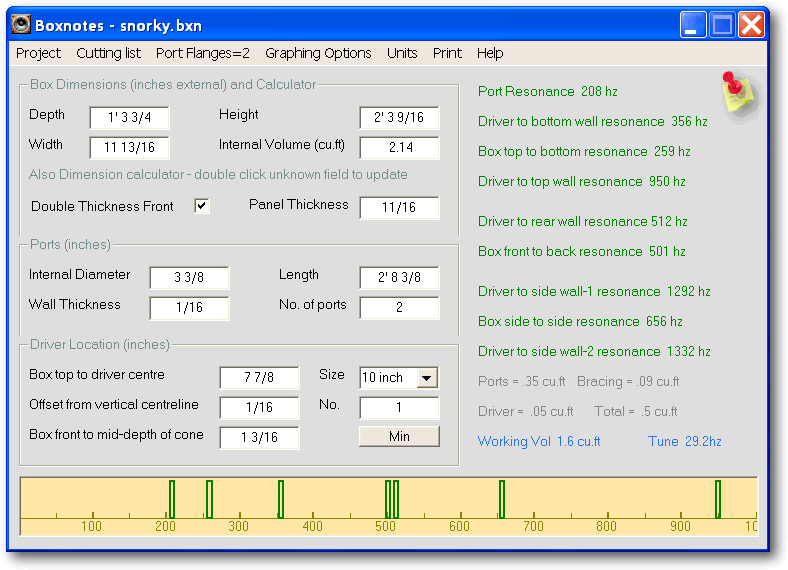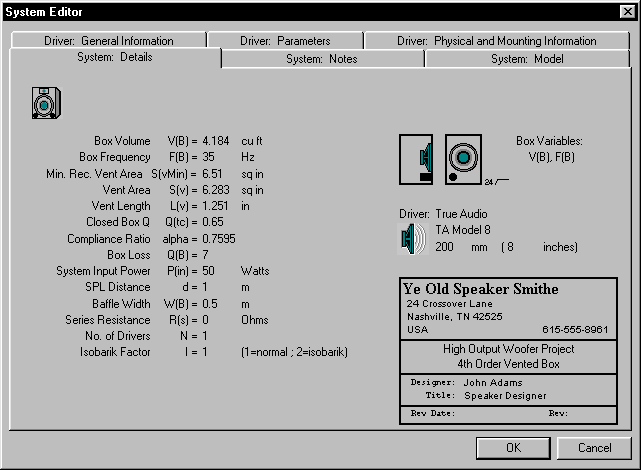To create a wonderful sound system, there is a need to have all the factors put into consideration. This is because designing of speakers is as much as science it is an art. To create most effective speakers, here are some of the best speaker design software that can guarantee you the top performance of the designs. As a matter of fact, the majority of them are the choice of the leading brands in the industry.
- Subwoofer Box Calculator software, free download
- Re Sub Box Calculator
- Speaker Box Tuning Calculator Software Download
- Speaker Box Calculator software, free download
This spreadsheet is the Swiss Army knife for subwoofer configurations. It helps you design, in real-time, cardioid configurations like end-fired and gradient. Physical (arc) and delayed (straight) horizontal arrays. You can use up to 12 speakers with omnidirectional, cardioid, super-cardioid and figure-eight speaker patterns. Subwoofer Box Calculator, free subwoofer box calculator software downloads, Page 3. Use this free software to assist you in building your 'sonosub' style subwoofer. Sonosub saves you having to get out the calculator to work out the sizes for your tubes. It also checks that your components will all fit with the correct clearances. Click to download Torres' Box Tuning Calculator.you'll need the most up to date.net framwork for this program to work. Click this link to get it.NET Framework. If you're.NET is up to date, and you're still having troubles opening the calculator, check to make sure it downloaded as a.exe file. It should have normally, but for some it.
Related:
Audio Subwoofer Design Software
Audio Subwoofer Design Software is a powerful software application that will allow the users to be in a position to create quality subwoofers and speakers. The software features an easy to use interface that makes it easy to monitor and calculates all the aspects that require.
WinISD
WinISD is a great speaker design software that is designed for the Windows platform. The software is 100% free and offers quite a wide range of features. With this, it is easy and possible for the users to create vented, bandpass as well as closed boxes that will deliver quality sounds.
Boxnotes
Box notes is an excellent speaker design software both for DIY enthusiasts as well as for professionals. It is the best loudspeaker design software available in the market and one that will guarantee top performance. It is well detailed as well as simple to use making it quite ideal for all users.
Other Platforms
As it is the case with the majority of the applications that require being installed into computer systems including those that are portable, the platform is key. This is critical in filtering the applications that can work for your case as well as those that don’t go to establish.
Speaker Designer for Android
Speaker Designer is an Android speaker design App that allows users to find some guiding parameters when it comes to designing various speakers. The App being on smartphones and tablets make it quite convenient for the user to access the required info and consequently come up with the best speaker.
GSpeakers for Mac
GSpeakers is a Mac-based 3D speaker box design software that was conceived out of the necessity, the fact that there is a lack of an appropriate software on the platform. However, the software is quite powerful and other being accessible on Mac OS, it can also be accessed from Linux and any UNIX system.
WinSpeakerz for Windows
WinSpeakerz is a free speaker design software that is provided for evaluation purposes to give an opportunity to sample the premium software. With this, it is possible and easy to realize the full power as well as the future of loudspeaker simulation and designing.
Most Popular Software for 2016 – FINEBox
FINEBox is the leading speaker design software. With this application, it designing of headphones, micro loudspeakers, PA systems, and Hi-Fi systems is greatly simplified and results much more effective. The software also offers rich features such as 3D display of the various elements as well as a simulator for different designs.
What is Speaker Design Software?
A speaker design software is a computer application that is developed to assist the designers of speakers in bringing out the best designs that will have various effects. Essentially, the software in this category will pick all the components of the speaker being developed in terms of measurements as well as the type of materials being used. You can also see Music Editing Software
From these, the software is able to simulate the sound quality that the speakers being designed will be in a position to produce. As a result, it is possible to expect the very best in terms of performance as well as optimization. You can also see Digital Music Player
Computer aided designs as well as simulation are areas that have led to the development of products that could have otherwise been very challenging to have. There is no exception in the field of speaker designs as it can be noted that there are quite a good number of these applications.
Related Posts
1. Background
The very first version of SubwooferSimulator was abasic Vented-Box calculator compiled in one little MS-DOS command-lineutility. The MS-DOS executable file used equations from RayAlden's book,'Advanced Speaker Design for the Hobbyist and Technician.' The utility simply calculated net enclosure volumes and port dimensionsoff one 'alignment'. It was all I could do since I neither hadthe time nor patienceto hard code a graphical user-interface using only a command-linecompiler. I had to use a 2nd software to plot my program'soutput files.
It was when Borlanddecided to let AustralianPersonal Computer Magazine release Borland C++Builder 3.0 Standard to the public that I started my journeyinto the challenging world of loudspeaker CAD softwaredevelopment. After a month of reading Builder's helpfiles andexampleprograms, I was able to build a fully-independent simulation program,which is pictured below.
Fig. 1: First SubwooferSimulator.
The mosttime-consuming part was making the graphingfunctions. I disliked what was already available, so I made myown plotting routines. As you can see, the plots weren't perfectaround the edges; curves tended to 'overshoot' the graph space. After the graphing functions werecompleted, though not necessarily bug-free, the next time-consumingpart of making the user-interface followed. Anyway, it wasAugust, 2001 when I released the old version to the public.
2. Specifications
2.0. System Rquirements
Any machine runningWindows 95 is good enough.
2.1. Electroacoustics Model
Subwoofer Simulatoruses pre-programmed 'equivalent circuits' tomodel 7 types of subwoofer designs. All the models have theirelectrical and mechanical parts transformed to their acousticalequivalent, which greatly simplifies circuit calculation. Pleasesee Electroacoustic Modeling Of AVented-Box Loudspeaker for an example of this simulation method.
The models used are ofthe small-signal type, and the simulation results are accurate so longas the driver unit in question remains linear at the (user-adjustable)simulation conditions. The results can be relied upon so long asthe driver unit stays within linear Xmax, thermal power handling limitand cone breakup... All of which are conditions easily-met giventoday's high-quality subwoofers from Adire Audio, AE Speakers (formerlynamed Stryke Audio) etc.
Subwoofer Simulatorsimulates:
| Sealed | Vented | Enclosurewith Passive Radiator | 4th-orderBandpass |
| Parallel6th-Order Bandpass | Series6th-Order Bandpass | 8th-OrderBandpass |
Subwoofer Simulator allows for 1, 2 orall 7 types of subwoofers to be simultaneously simulated, however, onlyone instance of each type is supported in the current softwareversion. The next version will be more flexible and have lotsmorefeatures.
I have made thegraphing part of subsim to show multiple curves in one page only sothat users may clearly see the relationship between each curve. This isnot only educational for beginners, but also informative for knowledgeddesigners. Moreover, all curves corresponding to each box type areshown on the same page, which allows for easy comparison of box designs.
The currentversion of subsim does not automatically adjust the extremes of theY-axes. However, all X-axis and Y-axis maximum and minimum values maybe easily changed by clicking the supplied Up/Down buttons or Up/Downkeys for keyboard bashers.
SubwooferSimulator plots:
- Cone and port excursion
- Group Delay
- In-Room frequency response (given the user's room transfer function)
| Frequency (Hz) | Magnitude (dB) | Phase (degrees) |
| 10.000 | 80.000 | 90.000 |
| 11.000 | 82.000 | 85.000 |
| 12.000 | 83.000 | 80.000 |
| ... | ... | ... |
| .. | .. | .. |
| . | . | . |
In order to help the user distinguish which curve is which, the userhas the option to change the color of each curve. Colors areautomatically saved when a simulation is ended or when subsim isclosed; the last saved colors are loaded everytime subsim is opened.
Clicking anywhere outside the graph space recalculates everything.
2.3. Create/Load/Save Project Files, DriverFiles, Box Files...
Subwoofer Box Calculator software, free download
| Enclosure Part | - | Changed by adjustments of any/all of: | - | Notes |
| Fb | Vb, Av, Lv, PR parameters, number of vents/PRs | |||
| Lv | Vb, Fb, Av, number of vents | |||
| +m | Fb, number of PRs | |||
| PR Parameters | number of passive radiators | to reflect a single equivalent PR |
3. Quick Startup Guide


4. Notes
Re Sub Box Calculator
Speaker Box Tuning Calculator Software Download
-- multiple woofers may be usedwith the program simply bymanipulating the T/S parameters of the woofer used. The single-wooferequivalent T/S parameters are:
| For x woofers in parallel: | ||||
| Revc | = | Revc/x | ||
| Levc | = | Levc/x | ||
| Fs | = | unchanged | ||
| Vas | = | x*Vas | ||
| Qms | = | unchanged | ||
| Sd | = | x*Sd | ||
| Bl | = | unchanged | ||
| For x woofers in series, as above, but: | ||||
| Revc | = | x*Revc | ||
| Levc | = | x*Levc | ||
| Bl | = | x*Bl | ||
| For parallel voice-coils: | ||||
| Revc | = | Revc/2 | ||
| Levc | = | Levc/2 | ||
| Fs | = | unchanged | ||
| Vas | = | Vas/2 | ||
| Qms | = | unchanged | ||
| Sd | = | unchanged | ||
| Bl | = | unchanged | ||
| For series voice-coils, as above, but: | ||||
| Revc | = | 2*Revc | ||
| Levc | = | 2*Levc | ||
| Bl | = | 2*Bl | ||
5. Things To Come
6. Download Details
| SubSim ZIP File | size = | 851kB |
| Uploadedon May, 2002 | ||

Speaker Box Calculator software, free download
Kindly email me to arrange commercial use.
Please email me if you'dlike to donate any sum of money.